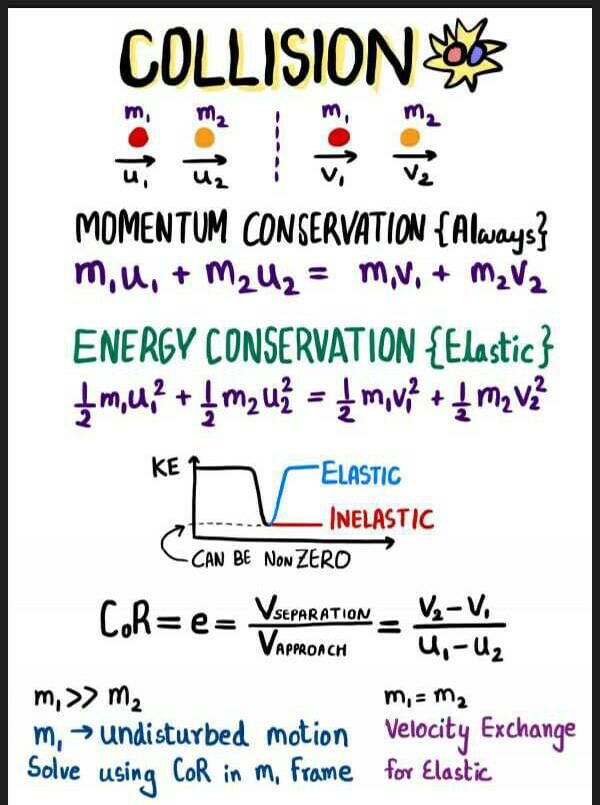NEET Exam > NEET Questions > Formula sheet for COLLISION.don't answer plz?
Start Learning for Free
Formula sheet for COLLISION.don't answer plz?
Most Upvoted Answer
Formula sheet for COLLISION.don't answer plz?

Community Answer
Formula sheet for COLLISION.don't answer plz?
Collision Formula Sheet
Collision is an important concept in physics, especially in the study of momentum and energy. Here is a formula sheet to help you understand and solve problems related to collisions.
Types of Collisions
- Elastic Collision: When both momentum and kinetic energy are conserved.
- Inelastic Collision: When only momentum is conserved but kinetic energy is not.
Conservation of Momentum
- In a collision, the total momentum before the collision is equal to the total momentum after the collision.
- Mathematically, this can be expressed as:
\[m1u1 + m2u2 = m1v1 + m2v2\]
where m1, m2 are the masses of the objects, u1, u2 are the initial velocities, and v1, v2 are the final velocities.
Conservation of Kinetic Energy
- In an elastic collision, the total kinetic energy before the collision is equal to the total kinetic energy after the collision.
- Mathematically, this can be expressed as:
\[\frac{1}{2}m1u1^2 + \frac{1}{2}m2u2^2 = \frac{1}{2}m1v1^2 + \frac{1}{2}m2v2^2\]
Coefficient of Restitution
- The coefficient of restitution (e) is a measure of how much kinetic energy is conserved in a collision.
- It is defined as:
\[e = \frac{Relative\,velocity\,after\,collision}{Relative\,velocity\,before\,collision}\]
Impulse
- Impulse is the change in momentum of an object during a collision.
- It is given by the formula:
\[Impulse = Force \times Time = Change\,in\,Momentum\]
Understanding and applying these formulas will help you analyze and solve problems related to collisions in physics.
Collision is an important concept in physics, especially in the study of momentum and energy. Here is a formula sheet to help you understand and solve problems related to collisions.
Types of Collisions
- Elastic Collision: When both momentum and kinetic energy are conserved.
- Inelastic Collision: When only momentum is conserved but kinetic energy is not.
Conservation of Momentum
- In a collision, the total momentum before the collision is equal to the total momentum after the collision.
- Mathematically, this can be expressed as:
\[m1u1 + m2u2 = m1v1 + m2v2\]
where m1, m2 are the masses of the objects, u1, u2 are the initial velocities, and v1, v2 are the final velocities.
Conservation of Kinetic Energy
- In an elastic collision, the total kinetic energy before the collision is equal to the total kinetic energy after the collision.
- Mathematically, this can be expressed as:
\[\frac{1}{2}m1u1^2 + \frac{1}{2}m2u2^2 = \frac{1}{2}m1v1^2 + \frac{1}{2}m2v2^2\]
Coefficient of Restitution
- The coefficient of restitution (e) is a measure of how much kinetic energy is conserved in a collision.
- It is defined as:
\[e = \frac{Relative\,velocity\,after\,collision}{Relative\,velocity\,before\,collision}\]
Impulse
- Impulse is the change in momentum of an object during a collision.
- It is given by the formula:
\[Impulse = Force \times Time = Change\,in\,Momentum\]
Understanding and applying these formulas will help you analyze and solve problems related to collisions in physics.
Attention NEET Students!
To make sure you are not studying endlessly, EduRev has designed NEET study material, with Structured Courses, Videos, & Test Series. Plus get personalized analysis, doubt solving and improvement plans to achieve a great score in NEET.

|
Explore Courses for NEET exam
|

|
Similar NEET Doubts
Formula sheet for COLLISION.don't answer plz?
Question Description
Formula sheet for COLLISION.don't answer plz? for NEET 2024 is part of NEET preparation. The Question and answers have been prepared according to the NEET exam syllabus. Information about Formula sheet for COLLISION.don't answer plz? covers all topics & solutions for NEET 2024 Exam. Find important definitions, questions, meanings, examples, exercises and tests below for Formula sheet for COLLISION.don't answer plz?.
Formula sheet for COLLISION.don't answer plz? for NEET 2024 is part of NEET preparation. The Question and answers have been prepared according to the NEET exam syllabus. Information about Formula sheet for COLLISION.don't answer plz? covers all topics & solutions for NEET 2024 Exam. Find important definitions, questions, meanings, examples, exercises and tests below for Formula sheet for COLLISION.don't answer plz?.
Solutions for Formula sheet for COLLISION.don't answer plz? in English & in Hindi are available as part of our courses for NEET.
Download more important topics, notes, lectures and mock test series for NEET Exam by signing up for free.
Here you can find the meaning of Formula sheet for COLLISION.don't answer plz? defined & explained in the simplest way possible. Besides giving the explanation of
Formula sheet for COLLISION.don't answer plz?, a detailed solution for Formula sheet for COLLISION.don't answer plz? has been provided alongside types of Formula sheet for COLLISION.don't answer plz? theory, EduRev gives you an
ample number of questions to practice Formula sheet for COLLISION.don't answer plz? tests, examples and also practice NEET tests.

|
Explore Courses for NEET exam
|

|
Suggested Free Tests
Signup for Free!
Signup to see your scores go up within 7 days! Learn & Practice with 1000+ FREE Notes, Videos & Tests.

























